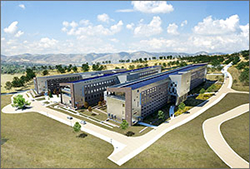
by Brianna Crandall — February 16, 2011—Thanks to $39 million in funding from the 2009 American Recovery and Reinvestment Act (ARRA), the U.S. Department of Energy’s National Renewable Energy Laboratory (NREL) was able to begin a planned 138,000 square foot expansion of its new Research Support Facility in Golden, Colorado, six months after the first phase of the RSF was complete.
Although the new RSF is considered one of the most energy-efficient office buildings in the world, the NREL team and the design, engineering and construction team have been challenged to increase energy efficiency in the new wing by 17 percent. Even though the first phase used many of the best construction practices and energy efficiency technologies available, those involved have been impressed by the improvement in commercially available building systems for the RSF expansion.
The expansion includes the following technology and design improvements and enhancements:
- More efficient solar panels were purchased at a lower cost;
- Less window area, while still fully daylighting office spaces;
- Larger transpired collector, creating more “free” warmed air;
- Better thermal breaks in the window frames, leveraging the latest in commercial windows and aluminum frames, driving down energy consumption and increasing comfort;
- Hand crank operable windows, increasing user friendliness;
- Automatically controlled outlets, simplifying energy savings for staff;
- Displacement ventilation in conference rooms, improving thermal comfort;
- Natural passive cooling in stair wells, vs. mechanical ventilation in the RSF;
- Triple pane east/west curtain walls, as compared to double glazing in the RSF;
- More flexible lighting controls with more lighting zones, allowing easier reconfiguration and enhanced user experience;
- Additional use of LEDs, further reducing the installed lighting power density;
- Simplified labyrinth design and reduced costs through enhanced thermal modeling;
- True vacancy sensors rather than switched occupancy sensors, simplifying lighting controls and occupant understanding of controls; and
- Daylighting controls in day-lit stairwells, allowing enhanced energy savings during the day.
- Less window area, while still fully daylighting office spaces;
The entire RSF will serve as a “living laboratory.” The team is already using energy monitors to study how well the components of the building are working, and how well various occupants in RSF are using their energy-efficient work stations. NREL says that the great news is that the staffers so far are sticking to their “energy budget,” which works out to only 55 watts per workstation.




